
Atlas F1 Technical Writer
Brazil did not bring with it many technical changes and for the most part, the cars were the same as those running in Malaysia, a fortnight before. Nevertheless, some progress was made and some new parts were seen. Craig Scarborough examines the components that made up the weekend of the Brazilian Grand Prix
Elsewhere at the front McLaren pushed for reliability and pace to distance themselves from the front of the midfield and in particular Renault and Sauber. The rest of the pack now have a better idea if their package has any underlying promise and are looking to the return to Europe to set about testing to solve their problems.
Despite most teams completing testing in the gap since the last race, very few new developments were in evidence, apart from a new wing for Minardi and completely new car for Ferrari.
A visible technical detail in this race was the teams adjusting the cars' set-up during pitstops, mainly limited to the Michelin runners. Many drivers opted to have the front wing adjusted during their sole pitstop to rebalance the car to the tyres.
The circuit came in for both praise and criticism over the weekend. During Friday, the cars had to run around and 'clean' the circuit, limiting set-up time in the pivotal Friday session. Many drivers had 'offs' on the slippy surface and two drivers suffered punctures. In fact, when Allan McNish's punctured tyre was removed from its rim, several nails were found inside to prove the cause of the failure. Moreover, if a driver suffers a puncture no additional tyre is allocated and effectively a crucial set of tyres is lost.
In favour of the circuit was the new tarmac run-off areas, used in place of gravel traps. These helped to slow a spinning car and provided the potential for the car to rejoin. Michael Schumacher, for example, spun on Friday and was "particularly happy with the new run-off area at the point where I spun just before the end of the session. If it had been as it was last year, I would have hit a barrier." Rubens Barichello worryingly pointed out they would not help stop a car with brake failure, highlighting the importance in selecting where the areas should be located around the circuit.
Enrique Bernoldi went off in turn 1, wiping the side off his Arrows, leading to a small fire. He stood up in his seat waiting for a safe moment to run across to the barriers, while the safety car was called and parked in front of the stricken car.
Several cars passed at diminished speed, but Nick Heidfeld was unsighted behind a Ferrari and swerved too late to completely avoid the Arrows. He went to the left and hit the open door of the safety car. No one was hurt in the accident, but with a working test version of the cockpit lights system to replace the flags, one must wonder when the FIA will introduce the system.
Tyres
While it was tyres that finally decided the outcome of the lead of the race, Bridgestone's overall win was not a clear demonstration of superiority over Michelin, as the French supplier had more cars near the top in qualifying and in the race.
Strategy was a bigger question mark in Brazil. The Bridgestone teams were split in choice of hard or soft tyre compounds and in whether to pit once or twice for fuel and tyres.
Michelin's Pierre Dupasquier explains: "If you look at a pure data simulation, take into account lap times, how much you lose by coming into the pits, refuelling time and so on, a one-stop race is faster." But he adds that there are other factors such as "the fact that some cars don't handle so well on a heavier fuel load," creating the need for two stops strategies.
A new Bridgestone tyre for this race performed well and was the option for Michael Schumacher, Nick Heidfeld, Giancarlo Fisichella and the Arrows cars. It was the harder option and hence would hinder qualifying performance in favour of durability in the race.
"The one-stop strategy was a team decision," Hisao Suganuma said of Ferrari's strategy, "but the fact they were able to do it demonstrates that our tyres had the capability. Looking at Michael's lap times, it's clear the new tyre we brought here helped the consistency of his performance in these hot conditions. Nevertheless, the gap to Williams was close and there is room for improvement on our part so we will be addressing this in our future development."
Team by Team
Ferrari
Ferrari finally brought the new F2002 car to a race - the sole existing F2002 chassis was tested at Barcelona before the race with several new aerodynamic parts not seen on the launch car, among them new flip ups and extra cooling vents. The F2002 has a unique rear profile, due to shared cooling chimney and exhaust outlets reaching up out of the sidepod tops.
Ferrari designer Ross Brawn had three worries about the F2002 during its infancy: gearbox reliability, cooling, and the rear suspension. These issues have all been ironed out during testing, but doubts still lingered.
Running both a F2002 and a F2001 as a T-car for Schumacher caused logistical problems for Ferrari, as the new car uses different wheels. As a result, Ferrari had a special dispensation from the FIA to have an extra allocation of dry tyres for the T-car, under the understanding that only seven sets are to be used over the qualifying and race days. This upset a few team bosses as it flouted the wording of the rules, but no protest was lodged.
The F2001 was the same car as in Australia and Malaysia, with the new two-element front wing developed for the F2002 added. Despite the older car believed to be a more reliable option, it suffered its second retirement in two races, compared to the clean reliable run the new F2002 has enjoyed this weekend.
On Friday, Barrichello had several offs due to a traction control problem on the dusty track, while Michael reported no problems. In qualifying, both drivers struggled a little with balance - Schumacher could be seen adjusting his brake balance before entering the more technical middle sector.
The battle for set-up and choosing strategy continued in the warm up, as Barrichello said more adjustment was needed on the car and Schumacher tried the new and the old car, using intermediate tyres, which although no use for the dry conditions would not affect his dry tyre allocation. He also ran differing fuel loads, leading other teams to believe the tyre conservation and mixed running were leading to a two stop strategy for Schumacher.
For the race, the cars had additional driver cooling installed - Rubens with his drilled windshield and Michael with a scoop in one of the panels in the top of the monocoque.
While the F2002's handling and braking during the race were expected to be superior to the Williams, the Ferrari's straight line speed parity to the Williams suggested the new car's aerodynamics and the low downforce race set up have a clear effect.
Williams
The Williams appeared once more in familiar guise, with no visible cooling ducts added despite the heat. Ralf Schumacher summarised the car's strong point for the circuit: "Part of it is definitely engine. Tyre-wise we should be looking good as well. It's the whole package. Our aerodynamic efficiency seems to be very good."
Juan Pablo Montoya lost a set of tyres due to a puncture on Friday, but still reported the new Michelins were working well with "much better grip and improved consistency." Ralf struggled with set-up and in finding a balance, as he had too much understeer. The team again spent Friday paying careful attention to the brakes, or as Montoya later said: "The brakes were working fine everywhere except into the first corner."
The situation remained the same for qualifying, with Montoya happy with some set-up and Ralf still chasing the right one. "I feel quite satisfied being a close third, but I didn't get the car quite right today," he said after the session.
For the race, the team chose a higher downforce set-up compared to Ferrari, with bi-plane rear wings with the third element mounted ahead and above the other two. They also started on scrubbed front tyres to minimise tail off in performance over the opening laps.
At his single pitstop, Montoya's tyres were well worn, with only the less loaded inner groove evident and only a trace of the second groove. Scrubbed front tyres were refitted and +1 turn of the front wing was added to combat the oversteer Montoya suffered after the first lap incident. Ralf's tyres were less worn, with the inner two grooves evident and only a trace of a third groove, and he too was treated to scrubbed front tyres and a front wing adjustment.
McLaren
The Mp4-17 car bore no visible changes since the last race. In Qualifying, David Coulthard's car looked stiff on early runs, the rear bouncing over the bumps, but this improved by the third run. Kimi Raikkonen had a problem in the morning and again on his first lap of qualifying, and had to switch to the spare and then back again to his race car.
Both drivers were happy with full tank running in the warm up and for the race, and sections were cut into the bodywork ahead of the winglets on the sidepod for extra cooling.
Interestingly, the tyres coming off Coulthard's car at his pitstop were less worn than the Williams, with most of the grooves still left on.
After his stop with three laps to go, Kimi Raikkonen's car spun off the track and was rocked violently as it flew over the gravel, leaving the right rear suspension askew. The team later reported the spin was caused by a rear wheel hub failure.
Renault
While Mike Gascoyne remained at the factory working on developments, Pat Symonds was in charge technically at the track.
A set-up change on Saturday left Jenson happy with the car's pace and said that, "we shifted some ballast for the later runs, but managed to keep the balance." In the warm up, both drivers had trouble-free sessions and were very happy with the set-up of the cars.
For the race, the cars were set up with a low drag three-element rear wing and the extra cooling ducts already seen this year. Button said the car was a little tricky during the first stint and took off some front wing during his pitstop for scrubbed tyres and fuel.
Trulli had the share of bad luck again and on lap 62 had a major engine failure on the straight, Renault's Denis Chevrier explaining it was "a sudden engine failure. It's still too early to say exactly what happened."
Sauber
The team were happy with progress, spending a lot of time on Friday running race set ups on heavy fuel and establishing downforce level to suit the power of the Ferrari based engine.
In qualifying, Nick Heidfeld spent several runs achieving a balance with the chassis and reported problems with the brakes. Felipe Massa at his home race experimented with old tyres on the front and new on the rear for his final run but wasn't able to improve.
Warm up produced no problems, but in the race Heidfeld had an as yet undisclosed problem. "I began to feel some really strange vibrations in the front end so I had to make an unscheduled stop and then was forced to retire," he said.
Jordan
The car ran well overall, albeit a little nervously on Friday and in qualifying. Furthermore, all weekend Takuma Sato seemed to be overdriving, going off the circuit during Saturday and outbraking himself into turn 1 several times in the race.
Giancarlo Fisichella had to start manually after a launch control problem. He then hit debris from the Schumacher-Montoya incident, and after pitting for a new nose he finally stopped on the circuit with a smokey engine failure - even though Honda are down on power to maintain reliability.
BAR
Both drivers completed a lot of laps on Friday with few problems or complaints. For Saturday, Jacques Villeneuve said the balance of the car was good, but Olivier Panis felt that "15th and 17th is not good enough and we have an engine problem here for sure." He later added, "it is very difficult to decide the best race strategy for the race."
The team eventually chose a split strategy, with Panis on a one stopper, but he never made it to the pitstop having retired with a gearbox failure.
Villeneuve also suffered reliability from the gearbox, with trouble during his pitstop and the engine cutting out on the final laps.
"A disappointing end to a very average weekend," David Richard summarised. "Not only are we not fast enough, but we still have reliability issues to address. We must ensure that the basic foundations are put in place as fast as possible and the changes within the team last week were made with this in mind."
Jaguar
However, despite the progress, both drivers complained that the car lacked aerodynamic grip and Eddie Irvine reported high-speed understeer. Nevertheless, no mention was made of the mechanical problems from the earlier races, and the package was reliable as both cars made it to the finish.
"The car felt quite loose out there today at times and keeping it on the road wasn't always easy," Irvine commented after the race. "The tyres have played an important part in our solid performance this weekend, but a lot of credit must also go to the team for extracting the best set-up possible."
Irvine had a engine problem during the race and was told on the radio told to turn on oil pump, the fact that this was not done via the newly legalised two way telemetry suggest Jaguar are busy on other areas of the car.
Arrows
With the car still not running anywhere but at a race for 6 weeks, the team spent a lot of time testing over the weekend. This was evident on Friday, when they fitted a sensor to the nose of the car. This untidy installation is usually run during tyre testing to measure the "slip" of the car when cornering and is never seen at race weekends. Furthermore, Heinz Harald Frentzen is still struggling to launch the car when the lights go off, and even his practice starts resulted in a stall.
In Qualifying, both drivers struggled with handling and Frentzen said: "we were basically fighting against understeer and oversteer in each of the four runs." Enrique Bernoldi also complained of excessive understeer and Frentzen missed most of the session due to another stall going out of the pits.
Come the race, both drivers finally got good starts, but later Bernoldi had to come in for repairs to a broken rear track rod. Frentzen too came in with the same problem, and while he retired Bernoldi was also called in for safety reason.
Minardi
Mark Webber was happy with the feel of his car and Alex Yoong's car looked twitchy as he was still learning the circuit. Eventually Webber qualified within one second of the top ten but still at the back of the grid. Team boss Paul Stoddart felt that, "the team has made significant progress from our last event" but put some of the performance down to Michelin, "for producing some fantastic tyres."
The team used warm up to decide their best fuel strategy for the race, with Webber choosing a one stop strategy. "The car was obviously heavy at the start with the strategy we had chosen," he said, but a problem limited his fuelling during the stop and had to make a splash and dash towards the end of the race. Yoong on a two-stop race suffered less from the same problem but also ran reliably to the end of the race.
Toyota
With their engine now considered among the top four most powerful engines in the pitlane, the long straights of Interlagos suited Toyota. Allan McNish found his pace very quickly running high up the timesheets on Friday and was delighted with the feel of the car. Mika Salo on the other hand suffered problems following some gear ratio changes.
Qualifying saw a reversal of fortunes, with Salo again beating McNish. Warm up brought a few more problems with traction control and chassis set-up. But come the race, Salo ran reliably to the finish in the points for the second time this season, while McNish was affected by the first corner incident but managed to stay on track.
"I made a good start and was making very good progress until Montoya hit Schumacher," McNish said. "I was just behind Mika when he pulled out and I hit Juan's wing, which was lying in the middle of the track. It damaged the nose of my car and punctured the front tyres, so I was forced to pit. The car's handling then got worse and worse with oversteer and, at Turn 4, the rear wheel locked up."
The race at Interlagos was all about Williams and Ferrari, with the usual factors of tyres and temperature separating them. With track temperatures topping 45 degrees, Michelin were expected to have the ideal product for this race, however this time Bridgestone and Ferrari turned the tables on Michelin to bring home a win, in the F2002's debut race.
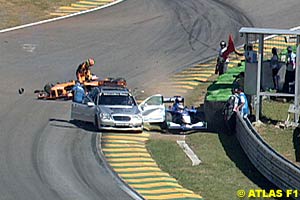 While safety is the overriding issue for the FIA, in Sunday morning warm up the ineffectiveness of warning flags was clearly demonstrated.
While safety is the overriding issue for the FIA, in Sunday morning warm up the ineffectiveness of warning flags was clearly demonstrated.
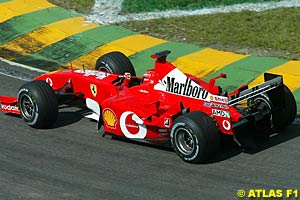 When on track, the car looked more of a handful than the neutral handling F2001; Michael Schumacher's hands worked the steering wheel much more, controlling the oversteer. Furthermore, the German didn't like the feel from the hand clutch to get the car off the line.
When on track, the car looked more of a handful than the neutral handling F2001; Michael Schumacher's hands worked the steering wheel much more, controlling the oversteer. Furthermore, the German didn't like the feel from the hand clutch to get the car off the line.
 In the warm up, the drivers scrubbed in their new tyres for the race, but were limiting their engine mileages. Ralf was happier with the set up, saying: "The car felt very almost perfect, apart from slight nervousness under hard braking."
In the warm up, the drivers scrubbed in their new tyres for the race, but were limiting their engine mileages. Ralf was happier with the set up, saying: "The car felt very almost perfect, apart from slight nervousness under hard braking."
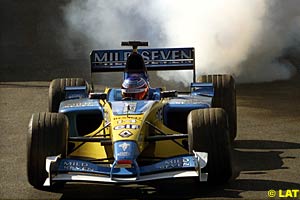 The team worked through cooling checks and established the overall gearing for the straights. Jenson Button managed to find a good balance for the car straight away on Friday, while still feeling there's more speed to be found in the car, and Jarno Trulli had problems preventing him completing his Friday programme.
The team worked through cooling checks and established the overall gearing for the straights. Jenson Button managed to find a good balance for the car straight away on Friday, while still feeling there's more speed to be found in the car, and Jarno Trulli had problems preventing him completing his Friday programme.
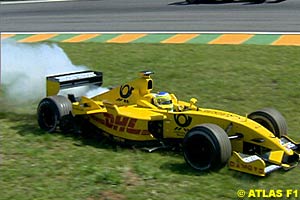 The car appeared with a cooling slot in the top left hand of the sidepod and cooling chimneys.
The car appeared with a cooling slot in the top left hand of the sidepod and cooling chimneys.
 With the R3 now the chosen car for the rest of the year, Jaguar took to task of making it work, and progress was certainly made over the weekend. Niki Lauda commented the car was "much better, thank God," and added that "the Michelin tyres have been good, yes, but for the first time this season we have extracted a very good set-up from the R3." The car used the cut down three-element front wing and the simpler barge-boards.
With the R3 now the chosen car for the rest of the year, Jaguar took to task of making it work, and progress was certainly made over the weekend. Niki Lauda commented the car was "much better, thank God," and added that "the Michelin tyres have been good, yes, but for the first time this season we have extracted a very good set-up from the R3." The car used the cut down three-element front wing and the simpler barge-boards.
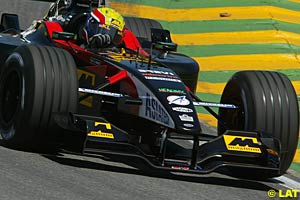 The sole new development on the grid was on the Minardi, with a new front wing that is wider and squarer in the middle "spoon" section.
The sole new development on the grid was on the Minardi, with a new front wing that is wider and squarer in the middle "spoon" section.
Please Contact Us for permission to republish this or any other material from Atlas F1.
|
Volume 8, Issue 14
Atlas F1 Exclusive
Massa and the Sauber Way
In the Spotlight: Pollock on BAR
Brazilian GP Review
Brazilian GP Review
Technical Review: Brazilian GP
Touche
Quel Chicane Mobile!
Reflections on Interlagos
Stats Center
Qualifying Differentials
SuperStats
Charts Center
Columns
Season Strokes
Elsewhere in Racing
The Grapevine
> Homepage |